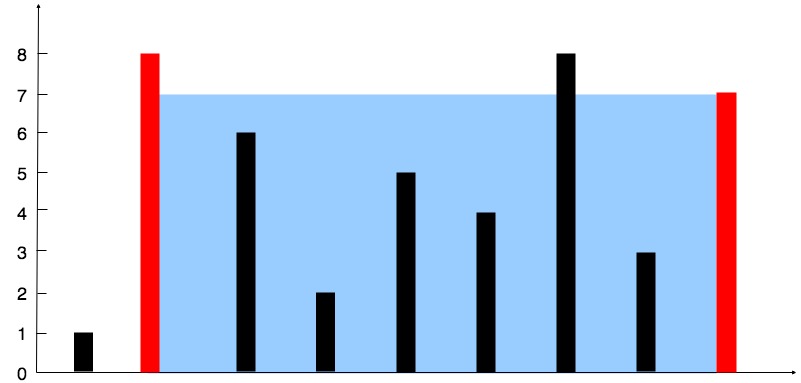Given n non-negative integers a1, a2, ..., an , where each represents a point at coordinate (i, ai). n vertical lines are drawn such that the two endpoints of line i is at (i, ai) and (i, 0). Find two lines, which together with x-axis forms a container, such that the container contains the most water.
Note: You may not slant the container and n is at least 2.

The above vertical lines are represented by array [1,8,6,2,5,4,8,3,7]. In this case, the max area of water (blue section) the container can contain is 49.
Example:
Input: [1,8,6,2,5,4,8,3,7] Output: 49
AC code:
class Solution {
public:
int maxArea(vector<int>& height) {
int count = 0;
int ans, num;
int len = height.size();
vector<int> v;
for (int i = 0; i < len; ++i) {
num = 0;
for (int j = len-1; j > i; --j) {
if (height[j] >= height[i]) {
ans = height[i] * (j - i);
num = max(num, ans);
break;
} else {
ans = height[j] * (j - i);
num = max(num, ans);
continue;
}
}
count++;
v.push_back(num);
}
sort(v.begin(), v.end());
return v[count-1];
}
};
Runtime: 472 ms, faster than 24.96% of C++ online submissions for Container With Most Water.
when i find the discuss, I find a way to improve the code's effectiveness.
The O(n) solution with proof by contradiction doesn't look intuitive enough to me. Before moving on, read the algorithm first if you don't know it yet.
Here's another way to see what happens in a matrix representation:
Draw a matrix where the row is the first line, and the column is the second line. For example, say n=6.
In the figures below, x means we don't need to compute the volume for that case: (1) On the diagonal, the two lines are overlapped; (2) The lower left triangle area of the matrix is symmetric to the upper right area.
We start by computing the volume at (1,6), denoted by o. Now if the left line is shorter than the right line, then all the elements left to (1,6) on the first row have smaller volume, so we don't need to compute those cases (crossed by ---).
1 2 3 4 5 6
1 x ------- o
2 x x
3 x x x
4 x x x x
5 x x x x x
6 x x x x x x
Next we move the left line and compute (2,6). Now if the right line is shorter, all cases below (2,6) are eliminated.
1 2 3 4 5 6
1 x ------- o
2 x x o
3 x x x |
4 x x x x |
5 x x x x x |
6 x x x x x x
And no matter how this o path goes, we end up only need to find the max value on this path, which contains n-1 cases.
1 2 3 4 5 6
1 x ------- o
2 x x - o o o
3 x x x o | |
4 x x x x | |
5 x x x x x |
6 x x x x x x
Hope this helps. I feel more comfortable seeing things this way.
code:
class Solution {
public:
int maxArea(vector<int>& height) {
int count = 0;
int ans, num;
int len = height.size();
int j = len-1;
vector<int> v;
for (int i = 0; i < len; ++i) {
num = 0;
for (; j > i; --j) {
if (height[j] >= height[i]) {
ans = height[i] * (j - i);
num = max(num, ans);
break;
} else {
ans = height[j] * (j - i);
num = max(num, ans);
continue;
}
}
count++;
v.push_back(num);
}
sort(v.begin(), v.end());
return v[count-1];
}
};
Runtime: 16 ms, faster than 53.39% of C++ online submissions for Container With Most Water.